Abstract
The purpose of the article is to study the effectiveness of using interactive learning tools in organizing classes in Programming in a distance format. Methods/Analysis: Various interactive tools are now widely used to organize elements of face-to-face learning, mainly for supporting student independent work. However, the use of these tools in a distance format, as well as the study of the possibility of expanding and modifying the forms of classes in these conditions, is quite an urgent issue to observe. Training with these tools takes place in three stages: preparatory, procedure and control. The application of such tools is based on the principle of individualized learning, when each student learns within his schedule, receives personal advice from a teacher, and has personal educational space. The authors organized the training in three subjects: Programming Technologies, Human-Machine interaction and Algorithms and Data structures to test the effectiveness of the study. Sholom- Aleichem Priamursky State University was the experimental facilities of the study. Findings: It was found out that using interactive learning tools in conducting classes allows one to increase the effectiveness of Programming subjects in a distance format. The results show that the improvement was 30 per cent in the experimental group, while the improvement was only 17 per cent in the control group. Applications / Improvements: Further research may be connected to the use of such systems to increase a variety of learning tools, as well as designing challenges to support these tools.
Keywords: Interactive learning tools, pervasive learning, social network, programming, automated task verification tools
Introduction
In present-day education, there are many tools to provide learning support. Systems are often used to organize the learning environment to control a student educational trajectory (Verdú et al., 2012). The number of automated environments has also increased significantly (Step.space…, 2020), which allow one to check up the tasks without involving a teacher (Alkaria, 2017). In addition, there is a significant increase in the use of mobile devices to enable learning anywhere with an Internet connection (Jones & Jo, 2004). To ensure the student involvement in the learning process, when using these tools, it is necessary to take into account such parameters as interactivity, the ability of the system to respond to human actions (Combéfis et al., 2016). On the other hand, the sanitary and epidemiological situation in the world has forced the use of these tools as a distance learning form with no chance of face-to-face review sessions. This, among other things, has caused a large number of developments in the field of indirect communication and communication in the network and involving these systems, including in learning activities.
In this study, this refers to the special peculiarities of distance teaching SAPSU students to the subjects devoted to Programming and the study of the effectiveness of this training in comparison with a similar process taking place in a classroom mode.
Problem Statement
In the current epidemiological situation, universities were forced to shift to distance learning, which caused several difficulties. The difficulties related both to the problems of finding the best means for organizing online classes in subjects, and reviewing the teaching aids and tasks for organizing this form of training. The inability to give lectures and personal tuition in a person-to-person format set a difficult task for teachers to provide information to students. In these circumstances, educators decided to gather a variety of tools that allowed one to organize communication with the groups of students quickly, complete practical tasks and test students’ skills.
The review reveals that there is an invariant set of educational tools for any training (Liu et al., 2020; Piteira et al., 2018; Smyk et al., 2020; Watanobe et al., 2020). Their use has a fairly long history, so there is already a stable set of course components. It should be noted that in this case, it refers to digital means and tools, however, analogue tools are quite amenable to digitization. In general, this list includes:
* Lectures: a text with possible hypertext, video with timestamps, audio recording.
* A set of test tasks: intermediate tests, tests for passing control points, final tests.
* Practical tasks in a wide variety depending on the subject taught and the approach.
Besides, when designing the learning process, most courses require a user’s profile; a place where data is collected about his achievements and the work that he needs to perform. One also needs a place to centralize all the components described above to obtain an externally unified logically interconnected structure. This list served as a foundation for further preparation for the courses.
Research Questions
The educators choose a social network as a means of a centre for interaction with students. Most social networks currently have a large number of functions for organizing group activities, such as Conversation, Community, etc. Besides, they can pin or download multimedia files, that is, there is a possibility of storing teaching aids within one resource. Within this study, instructors arranged a community to coordinate and support a group of students in three subjects, so the community became a centre of interaction between a teacher of these subjects and students (Figure 01).
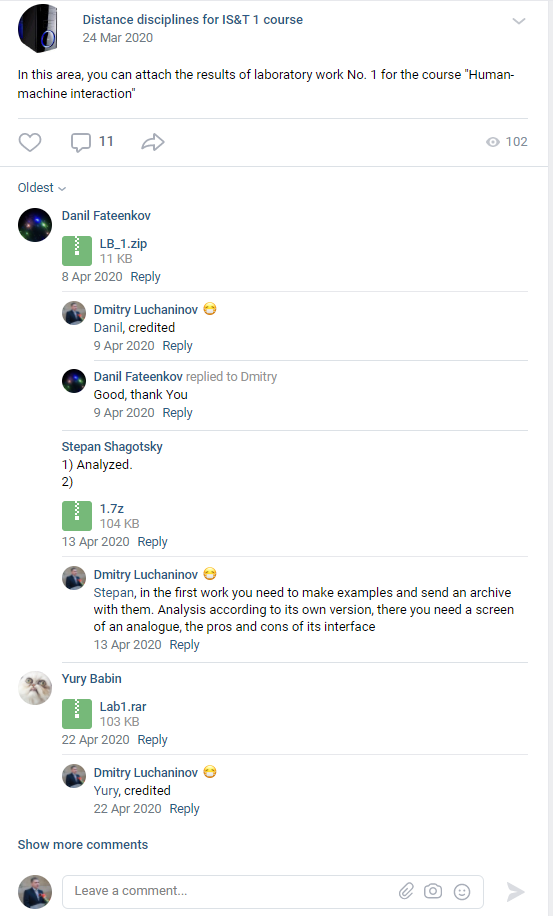
Through social networking sites, in addition to the YouTube video hosting system, broadcasts and record storage were organized for students who, for one reason or another, were unable to attend the classes. Two types of tools are usually used for this: pre-recorded video and broadcasts (streams). In the first case, it is reasonable to use recording programs, for example, OBS Studio, where it is possible to set various elements for output, such as a web camera, their order and visual effects. Also, Zoom and Skype systems were used for personal tuition and testing (Figure 02).
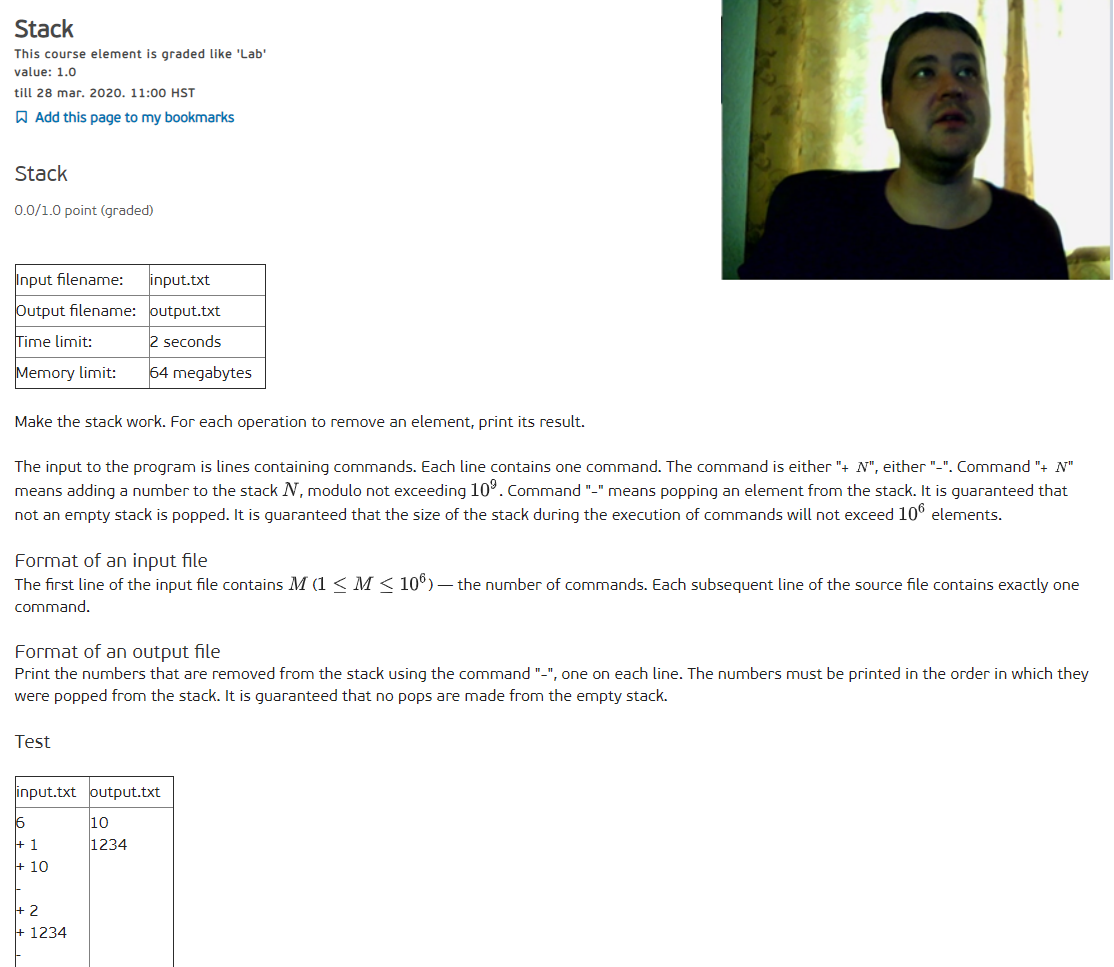
In many ways, learning Programming is connected with mastering a large number of examples related to the use of certain algorithms and algorithmic constructions. Within this approach, it is reasonable to use an automated system to check the solutions to the problems. Each task according to the standard used, for example, in the Olympic movement system ICPC, consists of several points (Fig. 03).
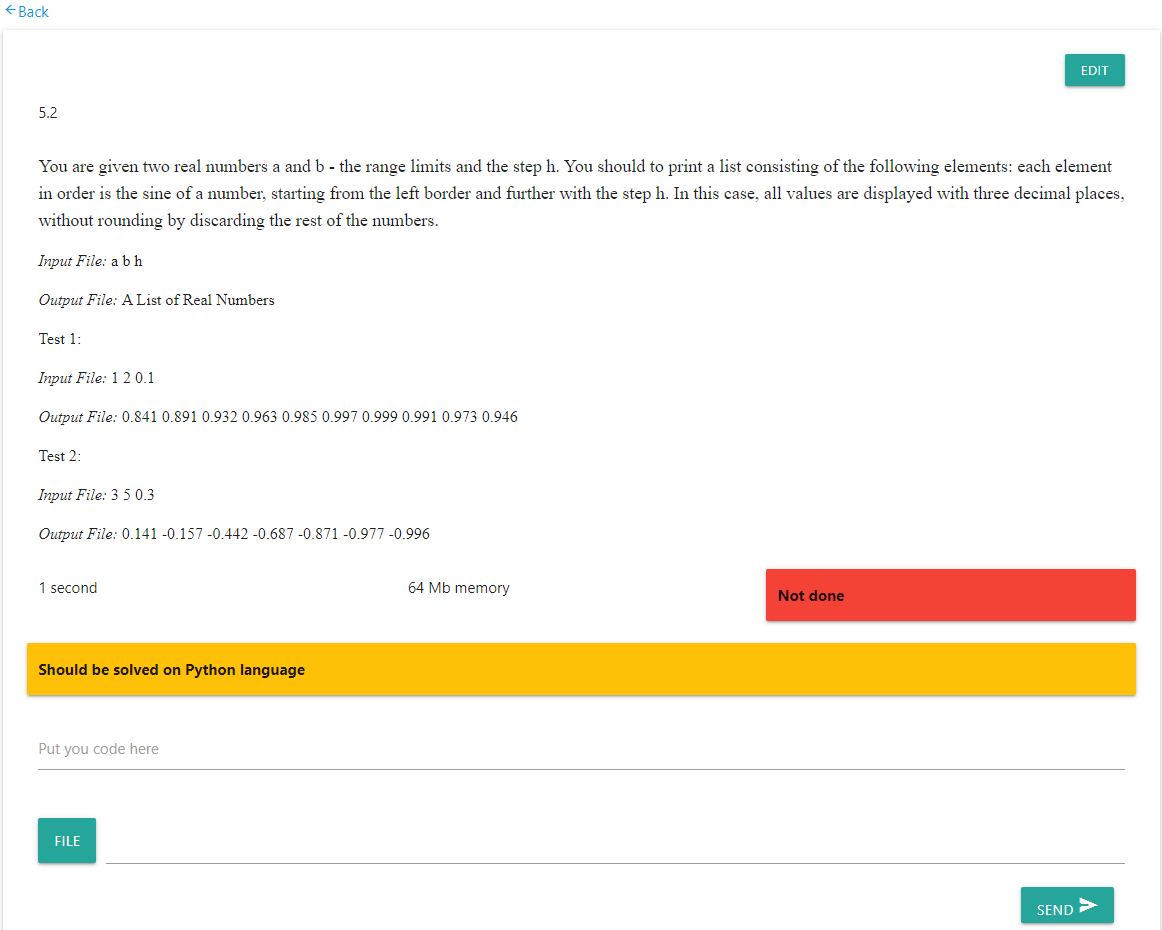
During the study, students receive points for completed tasks. If the task is completed incorrectly, the system issues an explanatory error, for example, that the program has exceeded the time or memory limit. During the entire training period, the teacher works as a tutor (Woods, 2020) through social media, helping students in difficult situations on subject issues.
Purpose of the Study
The purpose of the article is to review and observe the effectiveness of using interactive learning tools in organizing classes in Programming subjects in a distance format.
Research Methods
The authors arranged training in three subjects: Programming Technologies, Human-Machine Interaction and Algorithms and Data Structures to test the effectiveness of using interactive learning tools in Programming-related subjects in the 2019-2020 academic year. Sholom- Aleichem Priamursky State University was the experimental field of the study. As an experiment, a group of the first-year students majored in Information systems and technologies was selected. The experiment involved 14 students in the experimental group and 18 students in the control group. The control group was trained in the fall of 2019 in person-to-person training supplied with interactive learning tools. The experimental group was trained in the conditions of distance learning using the social media VKontakte as information and communication centre and automated task control systems. For the experiment, a community was arranged, where teaching aids were presented according to the following plan: the systems with automated task verification were set up for two subjects; the content was put directly in the community members for one subject. Besides, there was a link to the point-rating system, where students could monitor the points they were awarded for the subjects studied (Figure 04).
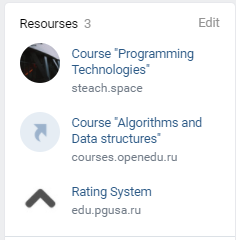
Teaching using interactive tools to test their effectiveness took place in three stages: preparatory, procedure and control.
At the preparatory stage, entry testing was conducted for each group of students. The teacher made up the tests based on the following content to assess the existing competence proficiency. Then, the teacher taught students how to use interactive tools with which they would deal with. For the control group, these tools were presented as classroom software, automated task verification systems. It was noted that they had an opportunity to use them outside the classroom to solve problems. For the experimental group, in addition to these tools, certain tools for communication guided by the teacher, organizing group work online with a teacher’s support, and the regulations for operating in a social media were presented.
At the procedural stage, the learning process was carried out. The peculiarities of it are mentioned above.
At the control stage, a final assessment was made. It allowed educators to quantify changes in the learning process. Technically, both the entry and final testing were carried out in Moodle. The questions for both groups were the same.
Findings
When evaluating students’ successes, a teacher used a hundred-point system. According to the assessment, all the students were divided into three groups according to their proficiency level: low (less than 33 points), medium (34-66 points), and high (more than 67 points) according to the test results. Since the study involved three subjects at once, the average value of the three test results was used as the scores for each student. The results of the study are presented in Figure 05.
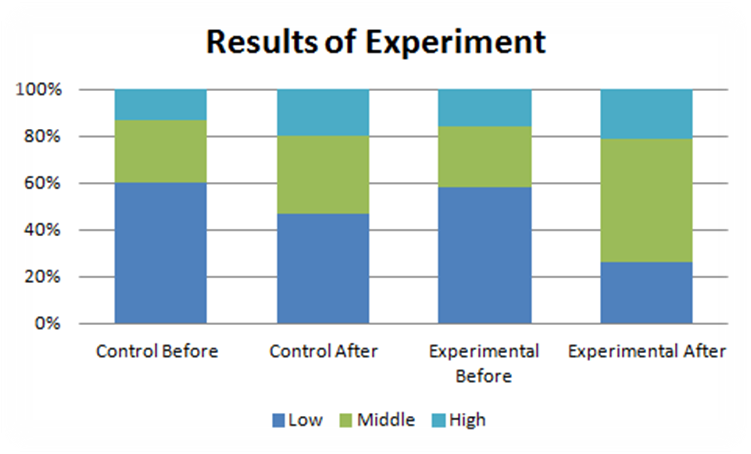
The results show that in the experimental group, the improvement was 32 per cent, vs only 20 per cent of the improvement in the control group. Besides, a significant decrease in the number of students in the low group should be noted, which stands for a positive motivational aspect in this approach to online learning.
Conclusion
Using the interactive learning tools in Programming subjects proves its effectiveness, especially in situations where the direct learning process is limited or impossible. Automated task verification systems allow one to maintain the intensive learning process. So the use of a tutor-based learning support approach allows one to avoid most problems with student motivation. It should be emphasized that using these tools allows for more effective teaching of low-level students, keeping high-level students on a progressive trajectory of vocational development. Further research can be related to the use of such systems to increase a variety of teaching tools, as well as designing task modules to support these tools. Finally, the development of interactive tools used can be referred to as intensification and automation of students’ textual and visual projects.
References
Alkaria, R. A. (2017). The Effect of In-Service Training of Computer Science Teachers on Scratch Programming Language Skills Using an Electronic Learning Platform on Programming Skills and the Attitudes towards Teaching Programming. Journal of Education and Training Studies, 5(11), 1-12. DOI:
Combéfis, S., Beresnevičius, G., & Dagienė, V. (2016). Learning programming through games and contests: overview, characterisation and discussion. Olympiads in Informatics, 10(1), 39-60. DOI:
Jones, V., & Jo, J. H. (2004). Ubiquitous learning environment: An adaptive teaching system using ubiquitous technology. Beyond the comfort zone: Proceedings of the 21st ASCILITE Conference, 468-474.
Liu, Z. Y., Lomovtseva, N., & Korobeynikova, E. (2020). Online Learning Platforms: Reconstructing Modern Higher Education. International Journal of Emerging Technologies in Learning (iJET), 15(13), 4-21. DOI:
Piteira, M., Costa, C. J., & Aparicio, M. (2018). Computer programming learning: how to apply gamification on online courses? Journal of Information Systems Engineering & Management, 3(2), 11. DOI:
Smyk, A. F., & Tkacheva, T. M., & Portnov, Y. A. (2020). New digital technologies of training in the transport education. IOP Conference Series: Materials Science and Engineering, 832(1), 012068. DOI:
Steach.space – Platform for learning programming languages. (2020). [online] steach.space.
Verdú, E., Regueras, L. M., Verdú, M. J., Leal, J. P., de Castro, J. P., & Queirós, R. (2012). A distributed system for learning programming on-line. Computers & Education, 58(1), 1-10. DOI:
Watanobe, Y., Intisar, C., Cortez, R., & Vazhenin, A. (2020). Next-Generation Programming Learning Platform: Architecture and Challenges. In SHS Web of Conferences (Vol. 77, p. 01004). EDP Sciences. DOI:
Woods, K. (2020). The Development and Design of an Interactive Digital Training Resource for Personal Tutors. Frontiers in Education, 5, 100. DOI: 10.3389/feduc.2020.00100
Copyright information

This work is licensed under a Creative Commons Attribution-NonCommercial-NoDerivatives 4.0 International License.
About this article
Publication Date
21 June 2021
Article Doi
eBook ISBN
978-1-80296-110-2
Publisher
European Publisher
Volume
111
Print ISBN (optional)
-
Edition Number
1st Edition
Pages
1-1168
Subjects
Social sciences, education and psychology, technology and education, economics and law, interdisciplinary sciences
Cite this article as:
Luchaninov, D. V. (2021). Usage Of Interactive Tools For Organizing Distance Classes. In N. G. Bogachenko (Ed.), Amurcon 2020: International Scientific Conference, vol 111. European Proceedings of Social and Behavioural Sciences (pp. 579-586). European Publisher. https://doi.org/10.15405/epsbs.2021.06.03.78

